There are significant recurrent costs attached to educating children and young people in all Australian schools.
In 2024, the minimum (or “base”) recurrent cost of school education for every Australian student is:
• $13,557 for a primary student, and
• $17,036 for a secondary student
Students in priority cohorts and disadvantaged schools attract higher amounts of funding to respond to specific needs and enable priority students to achieve their full potential.
Per student recurrent funding must be spent directly on recurrent costs, including students, staff and operating costs. It cannot be spent on capital expenditure for example a new building.
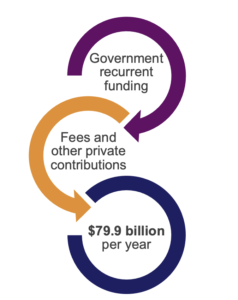
Who Pays for School Education?
Responsibility for the recurrent funding of education is shared by the Australian Government, state and territory governments, and parents and non-government school communities.
The Australian Government provides less than half of per student funding for Independent Schools, making private income the principal source of independent schools’ funding. NT Christian Schools comes under the Independent Schools category.
Government school students are mainly funded by governments, with state and territory governments contributing more than 95% of total per student funding for government schools.
Sources of Recurrent Funding, 2022
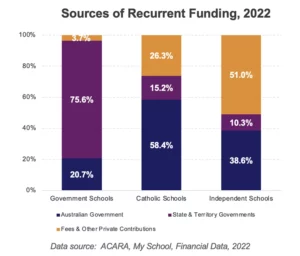
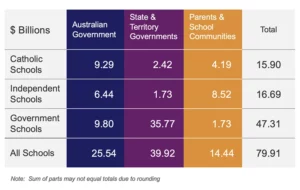
In addition to the $79.9 billion cost of educating students (called recurrent funding), schools incur additional costs for classrooms, libraries, sports facilities, and other capital projects (called capital expenditure).
Catholic and independent school parents and communities must raise the costs of capital projects privately, although disadvantaged schools can apply for assistance through government grants. In contrast, government school capital costs are mainly funded by state and territory governments with a small contribution from parents.
In 2023, NT Christian Schools invested $6 million on capital projects.
Sources of Capital Funding, 2022
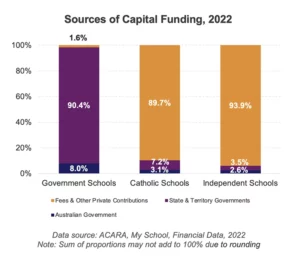
Sources of Capital Funding (Table) 2022
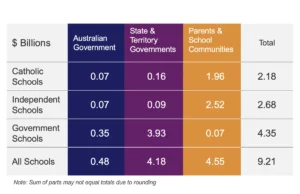
The Schooling Resource Standard (SRS) is calculated by Base Funding reduced by the Capacity to Contribute plus Loadings as illustrated below.
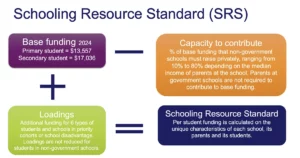
Base Funding
The Schooling Resource Standard (SRS) benchmark establishes the minimum cost of educating each Australian student. This minimum amount is called “base” funding. In 2024, base funding per student is:
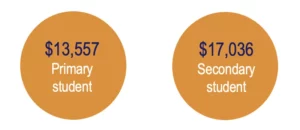
For non-government schools, per student base funding is means tested. These schools are required to raise between 10% and 80% of base funding privately, through fees and other private contributions.
How much a school must contribute to base funding depends on the median income of the school’s parents. This is called “Capacity to Contribute” and it only applies to non-government schools. Government support for non-government schools reduced by the same amount as each school’s private capacity to contribute.
Government funding: 2024 base SRS (Secondary)
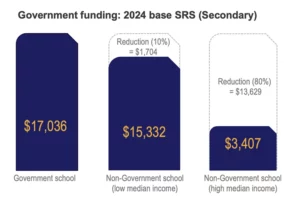
How is the Capacity to Contribute calculated?
Previously, each Catholic and Independent School’s Capacity to Contribute (CTC) was estimated using socio-economic information from the ABS 2011 Census calculated for areas where students live. These area-based estimates (called SES scores) were replaced in 2020 with a Direct Measure of Income (DMI) based on the actual financial data of the parents and guardians of students at a school. Financial information used in the calculation includes Australian Tax Office records and other income-related records such as PAYG and concession cards.
The new DMI measure was developed on a recommendation of the National School Resourcing Board’s review of the socio-economic status (SES) score methodology. Replacing area-based SES scores with a direct measure of family incomes enables a fairer and more accurate distribution of government funding to the students that need it most.
To create school DMI scores, the Australian Bureau of Statistics:
- Calculates family income for each student enrolled at a school by adding all of the income information available for that student’s parents and/or guardians
- Identifies the median (middle) family income from the set of all family incomes within the school
- Ranks all the median incomes calculated for all non-government schools
- Converts the ranked median income values into a set of DMI scores.
The Department of Education uses school DMI scores to determine each school’s capacity to contribute (it’s CTC score). A school’s CTC score is the rounded average of its annual DMI scores for the three most recent years. For example, a school’s DMI-based CTC score that applies to 2023 is the average of the annual DMI scores for the school worked out for 2020, 2021 and 2022.
CTC scores determine each non-government school’s private contributions to base funding, ranging from a 10% contribution for schools with CTC scores of 93 and lower, to 80% for schools with CTC scores of 125 or higher. Governments’ responsibility for base funding is reduced by the same amount, in accordance with the CTC schedule set out in the Australian Education Act (2020 amendment).
While a change from the previous SES area-based score to the DMI score improves assessment of need, some non-government schools will face substantial reductions in government funding. The DMI has applied to all schools since 2022.
The Australian Government Department of Education has published details of the methodology for the DMI. The Department, in partnership with the Australian Bureau of Statistics (ABS), will also apply a new Data Quality and Validation Framework to assess whether the data used to calculate annual DMI scores are fit for purpose. For a small number of schools where data does not pass the validation process, the Department will use a refined area-based SES score to calculate that school’s private contribution.
Additional funding called “Loadings” are added to base funding for students in priority cohorts and disadvantaged schools to address specific needs that individual students face. Loadings are not reduced by non-government school capacity to contribute, so that students in priority cohorts can attract the same loadings regardless of the schools they attend.
Four types of students and two types of schools attract loadings:
- Students with disability
- Aboriginal or Torres Strait Islander students
- Students with low English proficiency
- Students facing socio-educational disadvantage
- Regional and remote schools
- Small schools
Transition
- Every school in Australia is moving to the Schooling Resource Standard (SRS).
- However, some schools are currently funded above the SRS for historic reasons, and some are funded below the SRS.
- Governments have agreed to a transition period to enable schools to adjust to the SRS funding.
- In 2020 all schools began transition to the new funding model with full alignment to SRS funding expected by 2029. All NT Christian Schools campuses will not see this new funding until 2029 while government schools are seeing an incremental increase to funding every year up to 2029.